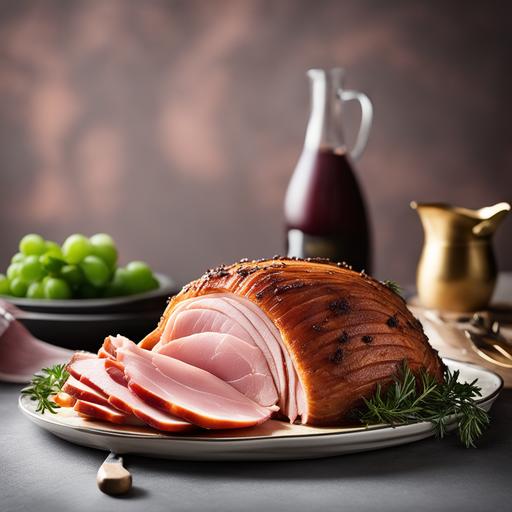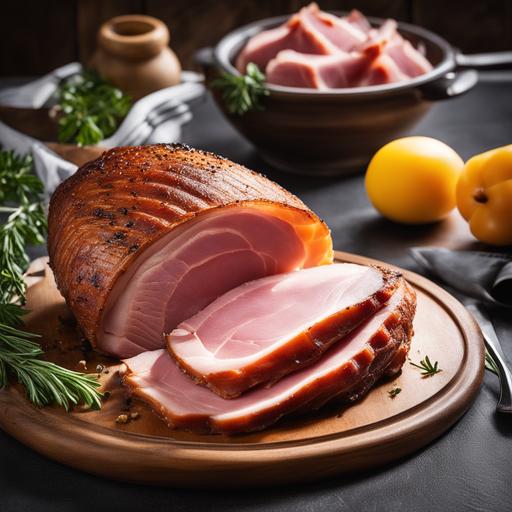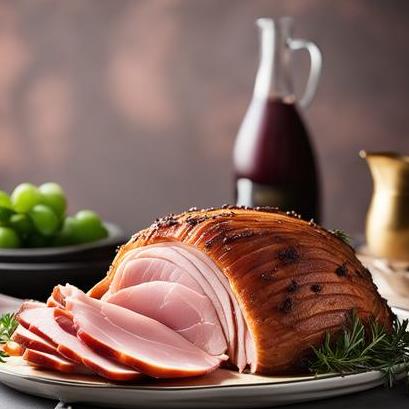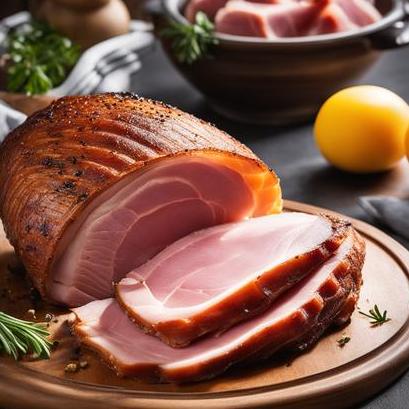
The Ultimate Guide To Cooking A Perfect Ham In The Oven
Ham is a delectable and versatile meat loved by many, and mastering the art of cooking it to perfection is a skill worth acquiring. In this comprehensive guide, we will delve into the intricate details of preparing and cooking a mouthwatering ham in the oven. From understanding the food science behind the process to exploring various culinary nuances, we aim to empower you with the knowledge needed to create a succulent and flavorful ham that will impress even the most discerning palates. So put on your apron, preheat your oven, and let’s get started on this delicious adventure!
Understanding the Food Science
Before we jump into the nitty-gritty details of preparing and cooking ham, it’s essential to understand the basics of the food science behind it. Ham is generally derived from the hind leg of a pig, and it undergoes a curing and smoking process to achieve its distinctive flavor and texture. During this curing process, the meat is infused with a combination of salt, sugar, and various spices, which not only enhances its taste but also acts as a preservative.
When it comes to cooking ham in the oven, the key is to apply gentle heat, allowing the meat to slowly cook through while retaining its moisture and tenderness. The high collagen content in ham ensures a gelatinous texture when cooked slowly, creating a melt-in-your-mouth experience.
Selecting the Perfect Ham
Choosing the right ham is paramount to achieving a delicious outcome. When browsing through the meat section of your local grocery store or butcher shop, keep the following factors in mind:
-
Type of Ham: There are three main types of hams: whole, half, and spiral-cut. Whole hams offer the most versatility as they allow you to control the cooking process fully. Half hams are pre-cut and are ideal for smaller gatherings, while spiral-cut hams are already sliced for convenience.
-
Bone-in or Boneless: Boneless hams are generally easier to carve and serve, while bone-in hams provide additional flavor and tend to be juicier. Personal preference should guide your decision here.
-
Ham Source: Opt for hams from reputable sources or local farms that prioritize animal welfare and use quality ingredients.
Cleaning and Preparing the Ham

Once you have chosen the perfect ham, it’s important to properly clean and prepare it before cooking. Follow these steps:
-
Rinse and Pat Dry: Rinse the ham under cold water to remove any excess salt or brine. Pat it dry with paper towels, ensuring you remove all moisture from the surface. This step helps achieve a crispier exterior during cooking.
-
Score the Skin: Using a sharp knife, make shallow diagonal cuts across the skin in a diamond pattern. This not only enhances the appearance of the cooked ham but also allows the flavors to penetrate the meat more effectively.
-
Glazing: If desired, you can apply a glaze to your ham for added flavor and visual appeal. Popular glazes include honey, brown sugar, maple syrup, mustard, or a combination of these ingredients. Apply the glaze evenly over the scored skin, ensuring it covers the entire surface.
Cooking Tips and Techniques

Now that your ham is cleaned and prepared, it’s time to explore some valuable tips and techniques to ensure a successful cooking experience:
-
Oven Temperature: Preheat your oven to 325°F (163°C) for the optimal balance of gentle heat and caramelization. This temperature ensures even cooking throughout the ham.
-
Cooking Vessel: Place the ham on a rack in a shallow roasting pan, which allows air to circulate around the meat and promotes even browning.
-
Basting: Basting the ham with its own juices or glaze periodically during cooking helps to lock in moisture and add flavor. Use a basting brush or spoon to apply the juices evenly.
-
Cooking Time: The cooking time depends on the weight of the ham and whether it is fully cooked or partially cooked. A general guideline is to allow 15-18 minutes per pound for fully cooked hams and 18-25 minutes per pound for partially cooked hams.
-
Internal Temperature: To ensure safe consumption, use a meat thermometer to check the internal temperature of the ham. For fully cooked ham, the thermometer should read 140°F (60°C), while partially cooked ham should reach a minimum of 160°F (71°C).
Variations and Flavor Enhancements

While cooking a traditional ham is always a crowd-pleaser, there are numerous variations and flavor enhancements you can experiment with to elevate your culinary creation to the next level. Here are a few ideas to inspire your culinary creativity:
-
Herb-Crusted Ham: Rub a mixture of finely minced herbs such as rosemary, thyme, and sage onto the surface of the ham before cooking. This imparts a delightful herbaceous flavor.
-
Fruit Glaze: Enhance the taste of your ham by incorporating fruity flavors like pineapple, orange, or apricot into your glaze. Drizzling the ham with a fruit sauce or adding fruit slices during cooking can create a tantalizing sweet and savory combination.
-
Spice-Rubbed Ham: Create a dry rub using a blend of spices like cinnamon, cloves, allspice, and nutmeg. Coat the ham generously with the rub before cooking to infuse it with warm and aromatic flavors.
Checking for Doneness

Properly checking for doneness is crucial to avoid undercooked or overcooked ham. Follow these steps to ensure your ham is cooked to perfection:
-
Internal Temperature: As mentioned earlier, use a meat thermometer to check the internal temperature of the ham. Insert the thermometer into the thickest part of the meat, avoiding any bone. Ensure it reaches the recommended temperature based on whether your ham is fully cooked or partially cooked.
-
Visual Indicators: The exterior of a perfectly cooked ham tends to have a golden brown color with a slightly caramelized glaze. The meat itself should appear juicy and tender.
-
Texture Test: Slice a small piece from the center of the ham and taste it. It should be moist, tender, and easy to chew. If it feels dry or tough, the ham may have been overcooked.
Recipe: Classic Oven-Baked Ham
Now that you are equipped with the essential knowledge, let’s dive into a classic recipe for cooking ham in the oven. This recipe is for a fully cooked bone-in ham.
Ingredients:
-
1 fully cooked bone-in ham (8-10 pounds)
-
1 cup brown sugar
-
1/4 cup Dijon mustard
-
2 tablespoons apple cider vinegar
-
Whole cloves for garnish
Instructions:
-
Preheat the oven to 325°F (163°C).
-
Rinse the ham under cold water and pat it dry with paper towels.
-
Score the skin in a diamond pattern, making shallow cuts across the surface.
-
In a small bowl, mix together the brown sugar, Dijon mustard, and apple cider vinegar to create the glaze.
-
Apply the glaze evenly over the surface of the ham, pushing whole cloves into the scored skin for additional flavor and decoration.
-
Place the ham on a rack in a shallow roasting pan, ensuring the cut side is facing down to retain moisture.
-
Bake the ham in the preheated oven for approximately 2.5 to 3 hours, or until it reaches an internal temperature of 140°F (60°C).
-
Baste the ham with its juices or glaze every 30 minutes to maintain moisture and enhance the flavor.
-
Once cooked, remove the ham from the oven and let it rest for 15-20 minutes before carving.
-
Carve and serve the ham, garnishing with the cloves if desired.
Avoiding Common Pitfalls: Overcooking and Undercooking
While cooking ham in the oven is a relatively straightforward process, it’s important to be mindful of potential pitfalls such as overcooking or undercooking. Here’s how to avoid these common errors:
-
Overcooking: To prevent your ham from becoming dry and tough, avoid leaving it in the oven for longer than necessary. Regularly monitor the internal temperature and remove the ham once it reaches the recommended temperature.
-
Undercooking: Undercooked ham is an equally undesirable outcome. Ensure your ham reaches the required internal temperature to guarantee its safety and optimal taste. If the ham appears undercooked, return it to the oven for additional cooking time while monitoring its temperature closely.
In Conclusion
Congratulations! You have successfully embarked on a culinary journey through the art of cooking ham in the oven. From understanding the food science behind ham to selecting the perfect cut, cleaning, and preparing it, as well as exploring various cooking techniques, variations, and doneness checks, you are now equipped with comprehensive knowledge to create a delectable ham that will be the centerpiece of any gastronomic gathering. So don your apron, unleash your creativity, and let your oven work its magic as you impress your family and friends with your newfound mastery of ham preparation. Happy cooking!
Sources
FAQS On Cooked Ham Oven Recipe
What Is The Best Temperature To Cook Ham In The Oven?
The ideal temperature for cooking ham in the oven is 325°F. However, it also depends on the size of the ham. For smaller hams, you can slightly increase the temperature to 350°F.
How Long Does It Take To Cook Ham In The Oven?
The cooking time also depends on the size of the ham. On average, it takes about 15-18 minutes per pound. So, for example, if you have a 8-pound ham, it will take around 2.5 to 3 hours to fully cook in the oven.
Do I Need To Cover My Ham When Cooking It In The Oven?
Yes, it is recommended that you cover the ham with foil while cooking it in the oven. This helps to retain moisture and prevents the ham from drying out. However, remove the foil for the last 20-30 minutes to allow the ham to brown and form a crispy outer layer.
Can I Add Glaze To My Ham Before Cooking It In The Oven?
Yes, adding a glaze is a great way to add flavor and moisture to your ham. You can use a variety of glazes such as brown sugar, honey, mustard, or pineapple. Apply the glaze about 30 minutes before the ham is fully cooked and remove the foil to allow the glaze to set.
How Can I Tell If My Ham Is Fully Cooked?
The easiest way to check if your ham is fully cooked is to use a meat thermometer. Insert the thermometer into the thickest part of the ham (without touching the bone) and make sure the temperature reads at least 145°F. Alternatively, you can also check if the juices are clear and not pink-colored. If the juices are still pink, then the ham needs more time in the oven.


